Welcome to Old School Month on Eternal Central. We’re looking at a different Old School 93-94 deck each day of the month. Today’s deck is Mono Green Workshop Aggro, appropriately named for playing green and Mishra’s Workshop, in an aggressive aggro shell. Here is a recent version I played.
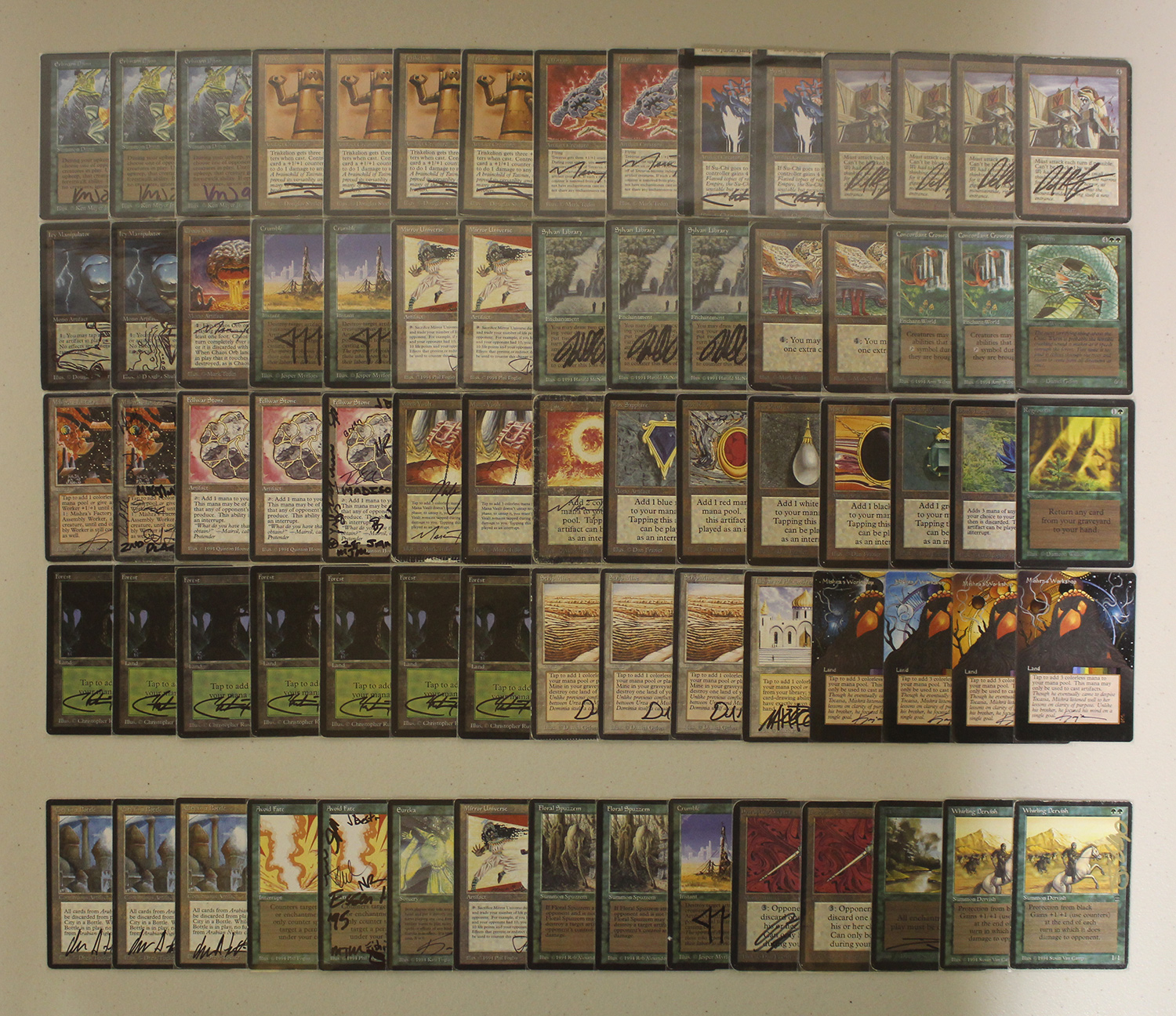
Constructing Mono Green Workshop Aggro
If you are a player coming from Vintage who already owns Mishra’s Workshops, but doesn’t own a ton of dual lands, this is a fun deck that caters to casting fatties and beating your opponent into submission. The presence of Mishra’s Workshop does not translate well to a budget strategy, unfortunately.
Creature Choices
When examining creature choices for Workshop aggro strategies, you must first consider your metagame, and what you wish to accomplish.
The preponderance of weenie creatures in a mixed metagame makes Triskelion an auto-include in Workshop decks. If your metagame is filled with hard control strategies this may lose some of the appeal, and you can bend down on the mana curve slightly to include more efficient threats, such that you can cast multiple threats in the same turn to play through countermagic.
To this end of bending the cost curve downward, Juggernaut is this most efficient colorless beater outside of Mishra’s Factory, but dies to a simple Chain Lightning, as well as the standard white removal package.
Su-Chi is harder to remove than Juggernaut, but in the American metagame that includes Mana Burn as a regular rule, this must be taken in to account when sequencing plays. It is often better to have a Mishra’s Factory or Jayemdae Tome in play before casting a Su-Chi, because if it is killed you can funnel the mana in to something else in order to avoid mana burn (or in the case of Jayemdae Tome, to draw a card and cantrip).
Likewise, Jade Statue is another card to seriously consider at the 4 mana slot, because not only is it on the lower scale of Workshop threats, but it also survives Lightning Bolt and Wrath of God, unlike Juggernaut. In this same vein, The Hive could be considered, but it is likely too slow for consideration in this particular deck, because we want to be swinging hard and fast to end the game sooner, rather than grind the opponent out turn after turn with an army of small fliers.
Tetravus is somewhat of an auto-include in Workshop decks because of the ability to fly over Moat[card], as well as block [card]Serendib Efreet[card] and [card]Serra Angel, as well as the critical ability to separate in to up to 4 individual fliers, in order to reduce the effectiveness of an opponent’s top-decked removal spell in-game.
Because this is a mono green deck, we also have access to some beef in the form of Ernham Djinn and Craw Wurm, which provide more flavor and muscle in our forward leaning stance. Ifh-Biff Efreet is unique in what it does, but the double green in the casting cost as well as small creature stats comparatively for what you’re getting leave it on the bubble for inclusion here.
The oft-overlooked Clockwork Avian is another colorless threat that provides flexibility and flies over Moat, but at 5 mana isn’t all that efficient. We’re skipping it in this particular version, but it should be kept in mind depending on what you’re trying to do with your deck.
The mana curve of 4 to 6 (or higher) must be taken in to account when balancing what quantity of each of these you’d like to include. I like to hedge on lower side, topping out with a handful of Triskelions and a couple Tetravus, as Triskelion is just naturally devastating against things like Savannah Lions, Preacher, and Knights of various flavors.
Draw Engines
Sylvan Library is the de facto draw engine for green decks, and is complemented by Mirror Universe in this build.
Jayemdae Tome is slow, but is easily castable off of a Workshop, and helps refuel in the mid-game. I like 1-3 copies in most Workshop decks, even though it is tempo negative. If your opponent is able to thwart your quick rush, this can help provide a stream of threats as the game trudges on.
Constructing a Mana Base
Given that this is a Workshop aggro deck, we want 4 copies Mishra’s Workshop, and some number of Strip Mine as a given. 3-4 Strip Mines is probably appropriate here, because it can act as a Time Walk in certain situations, while depriving the opponent of 2 blue mana or the ability to cast a timely removal spell in other situations.
Filling out the mana base here includes some number of basic Forests, as well as Moxen, Sol Ring, and a couple of Mana Vaults. Mana Vault can power out early threats if you lack Workshop, and can also help cast anything from Craw Wurm to Mirror Universe well ahead of curve. I like a couple of copies, but if you lack the fully powered acceleration package this can be subsidized with more Vaults and Fellwar Stones.
Designing the Sideboard
Green’s sideboard options are somewhat suspect, but at least provide artifact removal in the form of Crumble, and enchantment removal in the form of Tranquility.
City in a Bottle is an all-star for handling a variety of threats that are as efficient as yours, or more. Killing opposing Serendib Efreets for only 2 colorless mana is especially welcome, as this deck lacks many fliers. While this does interfere with your Erhnam Djinn’s, these can easily be swapped when sideboarding if you wish, as City is likely much more devastating against the decks you want to bring it in against.
Disrupting Scepter is another artifact that can come down early and have outsized, repeatable effects on a game, especially against control players. This often feels necessary against some of the decks with tons of removal as well, as if they can’t immediately Disenchant this, it will slowly empty their hand of creature removal.
Floral Spuzzem is similar to Trygon Predator in modern Vintage, in that if it can wipe out an artifact turn after turn if you can get it through unblocked. Another interesting addition to Crumble for artifact control.
Avoid Fate can act as a trump card against decks with limited removal spells. Countering the one removal spell your (non-white packing) opponent might find is often enough to get your large artifact threat cover to go aggro turn after turn and make short work of the enemy.
Playing Mono Green Workshop Aggro
Because of the mana requirements of your threats, it is important to sequence your land drops with an eye against protecting yourself from Strip Mine where possible. This often means shielding your Workshop or Forests until you need them to cast something on curve.
I like to lead with creatures that are weaker, with the realization that the first one or two will get countered or destroyed immediately, as there is plenty of removal in the format. All-stars like Triskelion and Tetravus are often free to complete clean-up duty after you have exhausted your opponent’s removal.
As in most green-based decks, Sylvan Library is one of the best cards, so you should seek to get this in to play after having baited out Counterspell for something else, or by trying to keep your control opponent off of double blue mana for a turn. Against the decks that can’t immediately remove it, Sylvan will likely deliver you plenty of mana or threats when you need them by virtue of repeatable card selection, turn after turn.
In a format with mana burn, Su-Chi can be a liability, so I like to play Jayemdae Tome or Mishra’s Factory first if I can, so that I will have something to sink mana in to, should Su-Chi be destroyed.
Ten Opening Hands with Mono Green Workshop Aggro
Here are ten randomly drawn opening hands with the deck (in order, and not manipulated in any way), and a few brief words with how I might look to play said opening hands.
Opening Hand 1
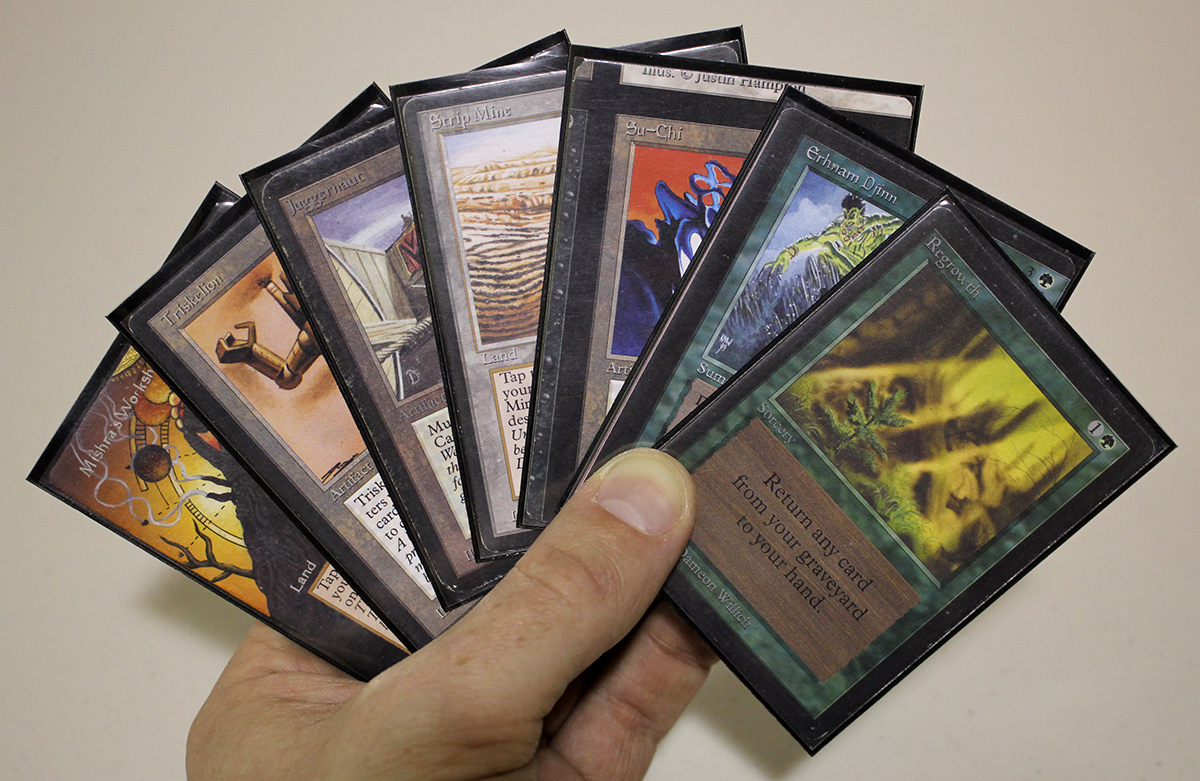
This hand lacks green mana to start, but has Strip Mine, Workshop, and a couple of easily castable threats. I’d keep this, and lead with Strip Mine first (to bait an opposing Strip Mine, potentially), and then follow up with Workshop in to Juggernaut on the second turn. Then run out the Su-Chi on the following turn, and depending on what else is drawn we can sequence appropriately from there.
Opening Hand 2
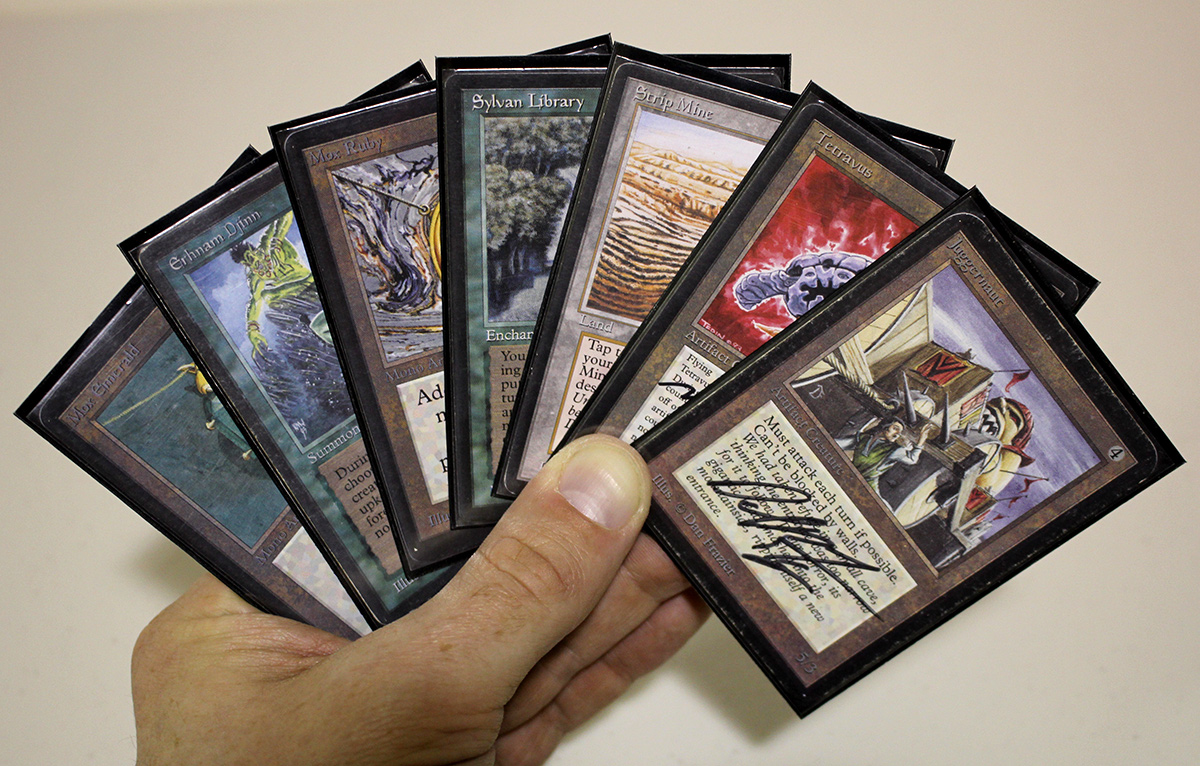
This is a strong hand featuring acceleration, Strip Mine, threats, and Sylvan Library. We’re casting the Sylvan on the first turn, and if on the draw we can also Strip Mine the opponent beforehand, if they’re holding up countermagic. If we’re on the play we have 3 mana already available, and if we find another mana with Sylvan we’ll likely have a second turn Juggernaut, followed by a third turn Erhnam Djinn.
Opening Hand 3
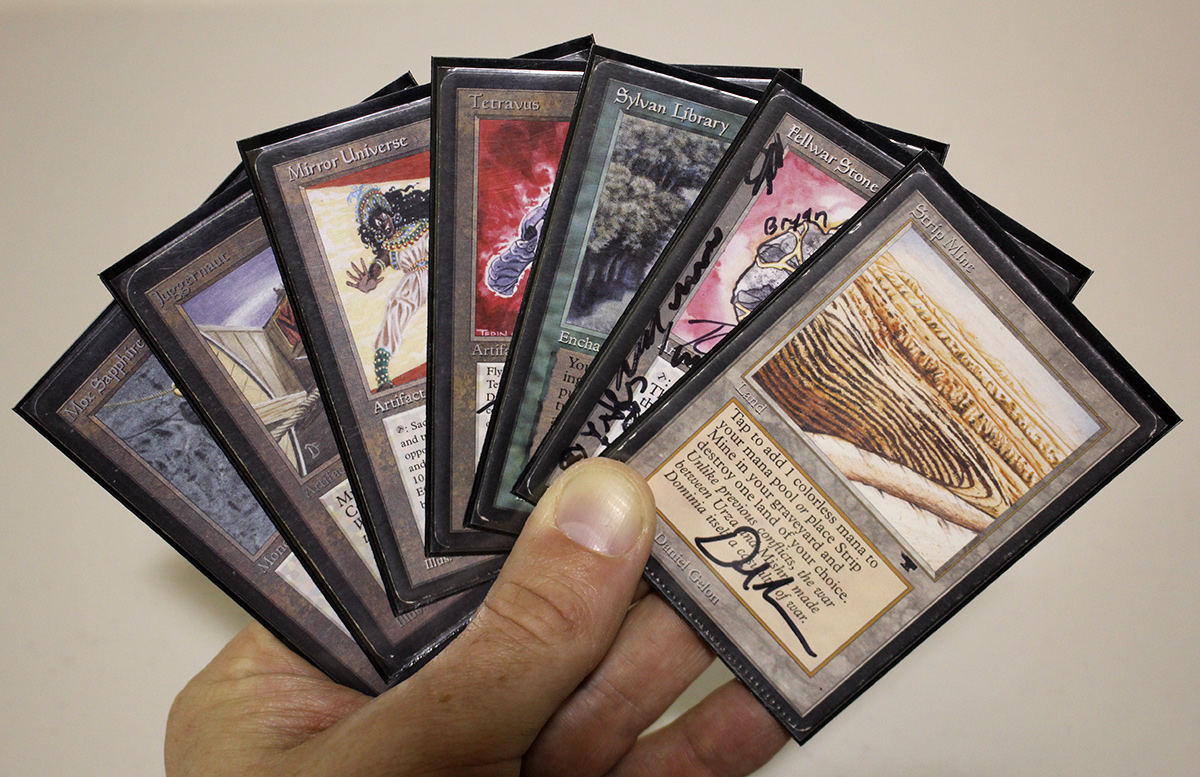
With three mana sources, but only one land, and a bunch of high casting cost cards, I’m going to throw this one back. You could talk yourself in to the first turn Fellwar Stone and hope to draw more mana plan, but this hand doesn’t really do much quickly, and can easily go sideways. I don’t love it, so I’ll try for a better six in this case.

Another one-land opener, but this time that land can help us cast a large threat on the first turn, with the potential to land Mirror Universe a couple of turns later. This isn’t a great hand, but is keepable, and forces the opponent to interact immediately. They must choose between trying to kill out creature, deal with Workshop itself, or advance their own game plan. This will likely lead to us losing something, but giving us time to draw out of it by finding more mana.
Opening Hand 4
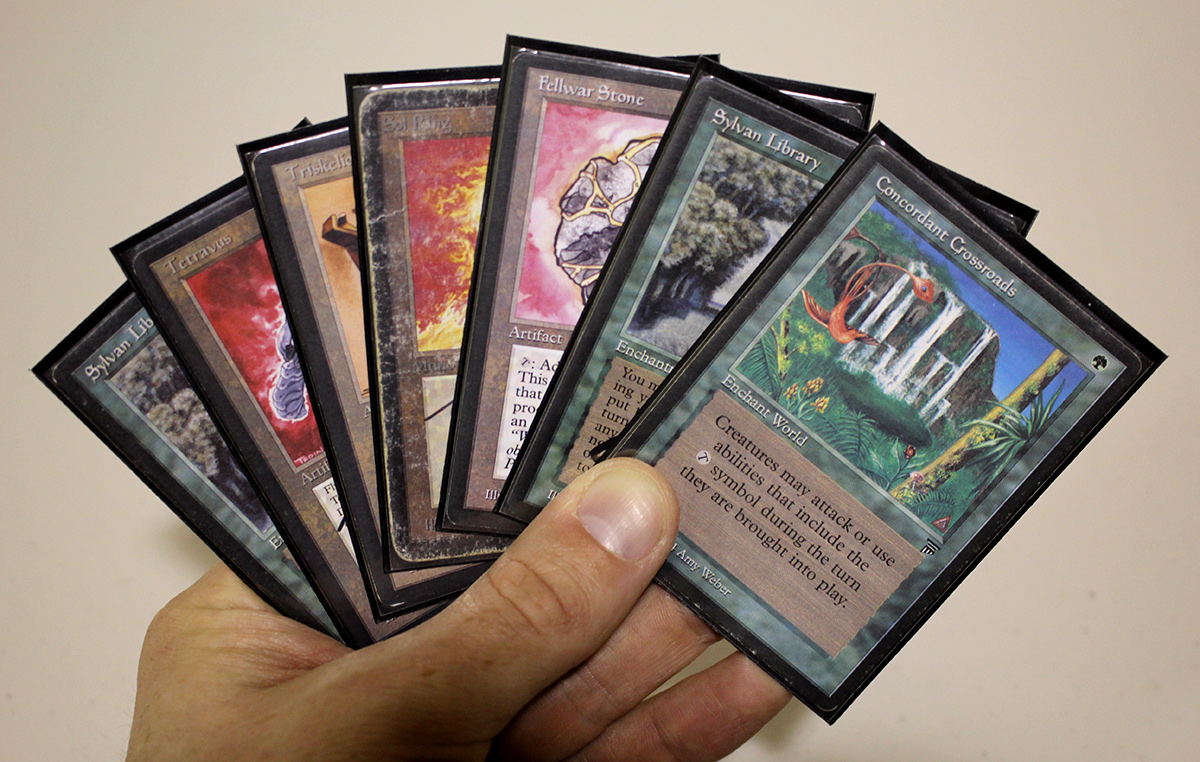
Without any mana to cast our spells this is an easy mulligan.
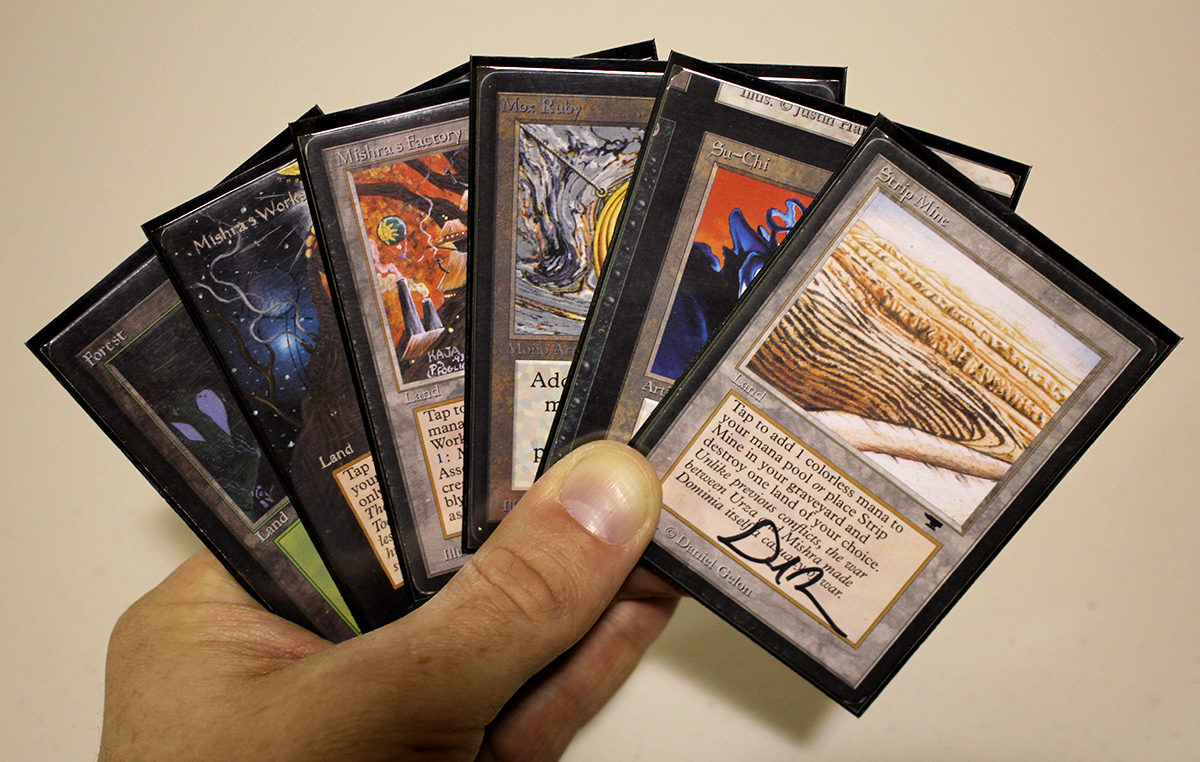
This hand represents a first turn Su-Chi, backed with a second turn Strip Mine to rewind the opponent’s board back a turn, generating immense tempo on your behalf. This is an easy keep, and even if our Workshop is dealt with, we have a nice spread of other mana to cast whatever is freshly drawn as the game proceeds.
Opening Hand 5
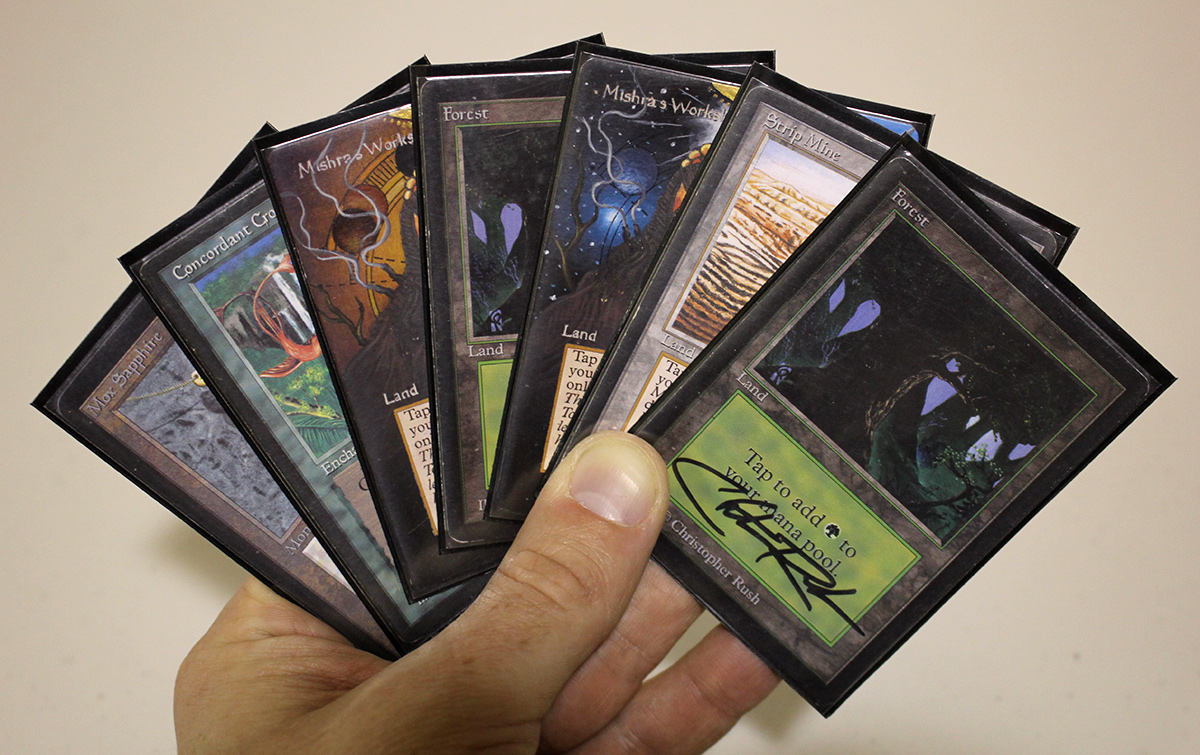
This hand lacks any threats, but has all of the mana in the world. I’m going to keep it and lead off with a Forest or Strip Mine, and hold Crossroads and the Mox in hand. We don’t want to cast Crossroads until we need it, and we don’t need to give the opponent any more information about our available accelerants. This can cast everything drawn from the deck, even after having our first Workshop killed, so that is enough reason to keep.
Opening Hand 6
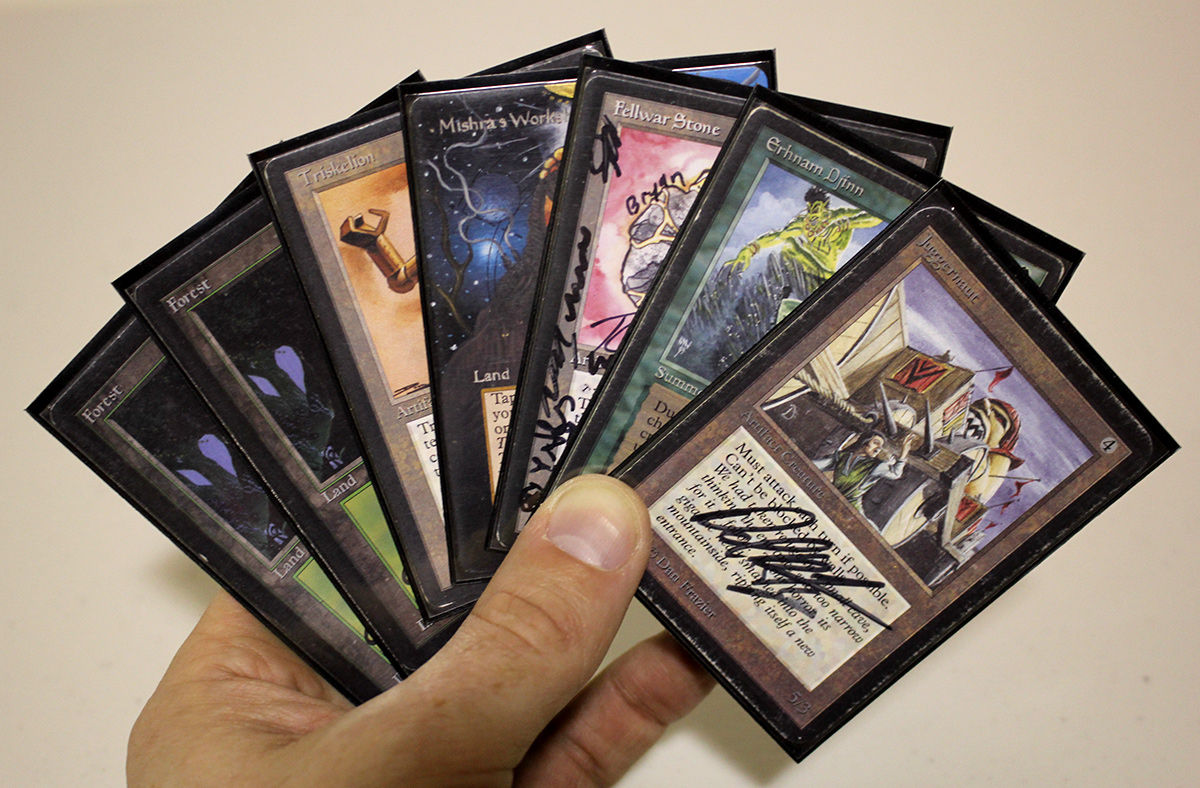
With threats and plenty of mana, this hand is a keeper. I’d lead with Forest into Workshop in to Juggernaut, and then follow up with Fellwar Stone after.
Opening Hand 7
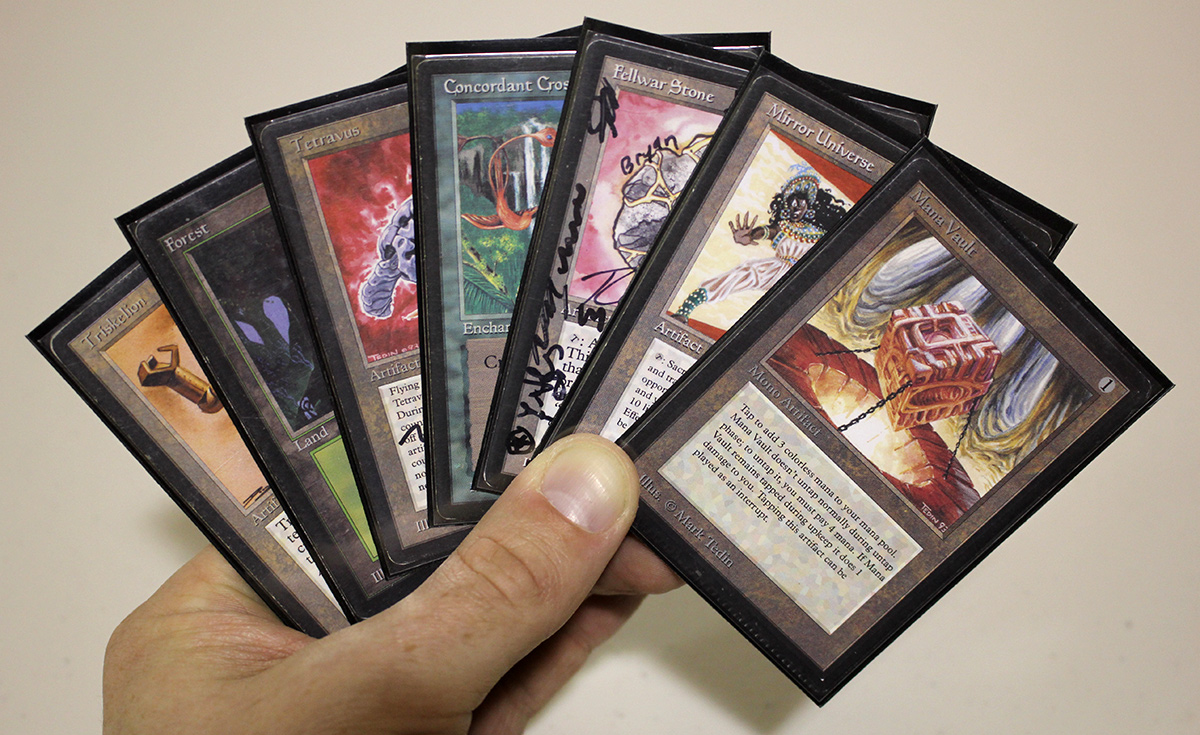
The threats in this opener are nice, but the mana is very dicey, and is probably not good enough to keep it. I’ll throw it back for a fresh six.
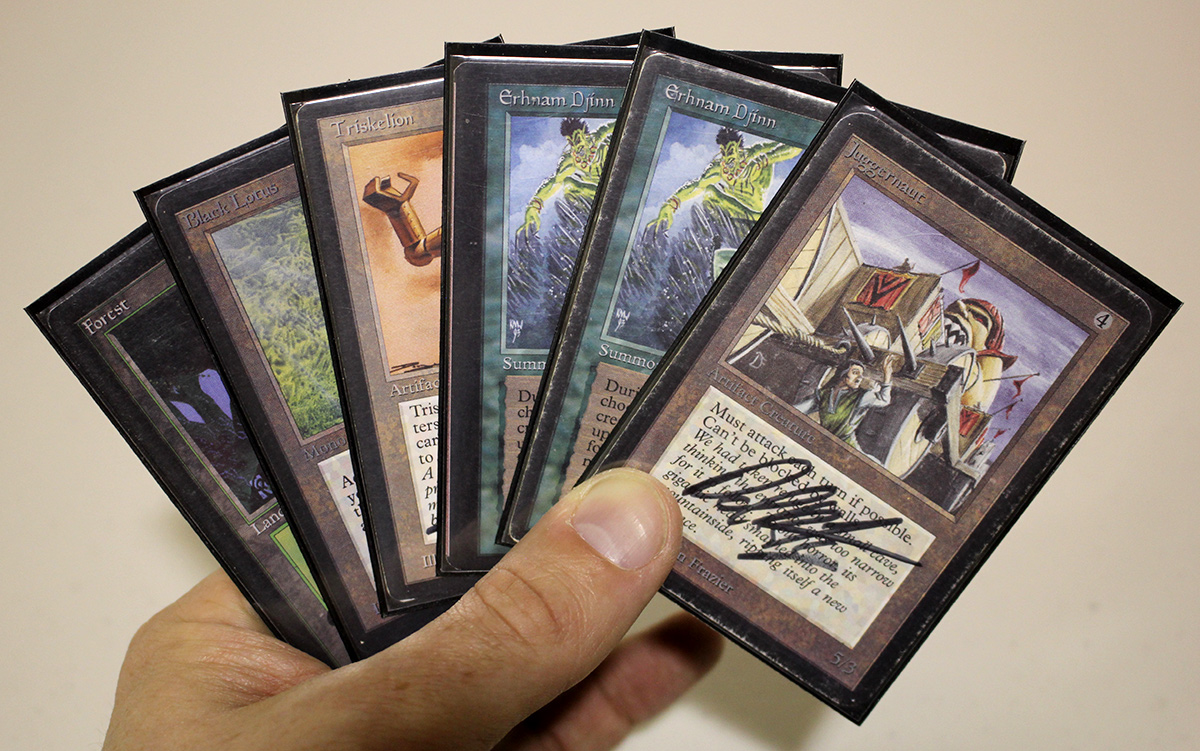
With only a single land yet again, this is not a great hand. It can play a large threat on the first turn though, and has plenty of gas if we can find more mana. I’d probably keep it, and lead with Forest and Black Lotus in to Erhnam Djinn (by virtue of being much harder to kill than Juggernaut). With the pre-game scry we’re going to be searching for mana only, and scry away anything that’s not a mana source.
Opening Hand 8
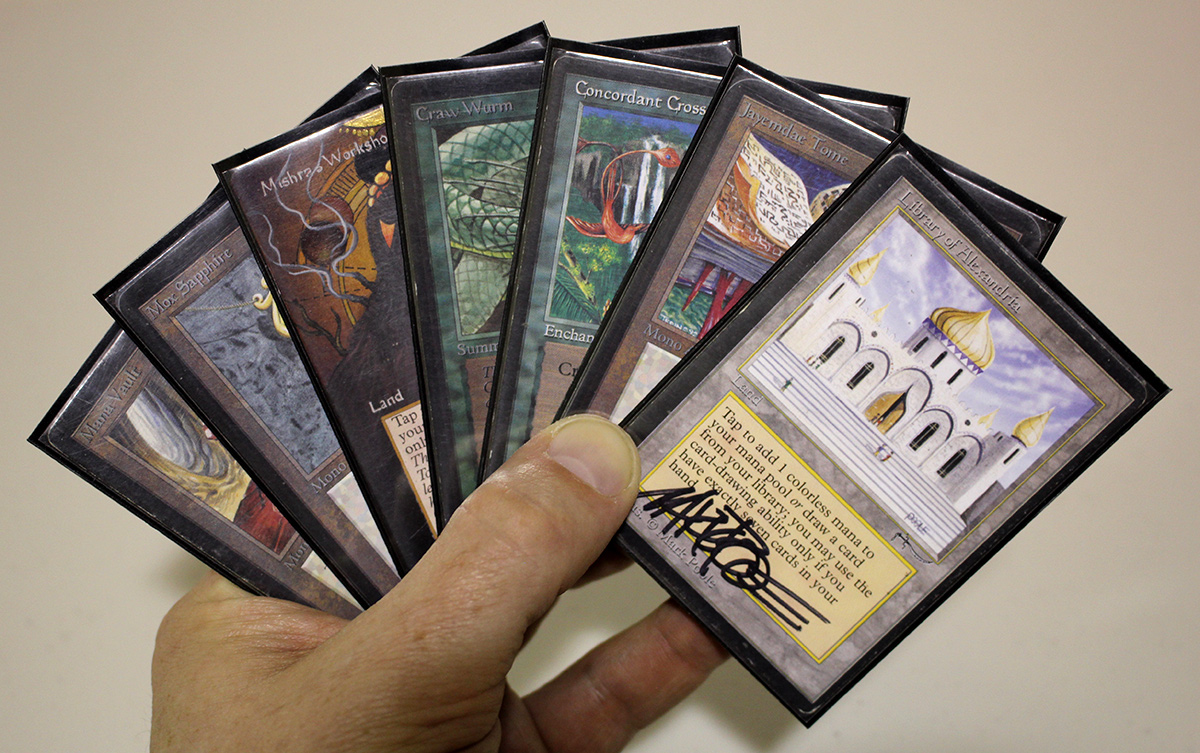
Library of Alexandria, Workshop, and Jayemdae Tome are enough to keep this hand. The acceleration is just a bonus, and the green cards won’t matter for a few turns at least. If your first turn Library is dealt with, proceed to use Workshop to power out Tome for additional card advantage.
Opening Hand 9
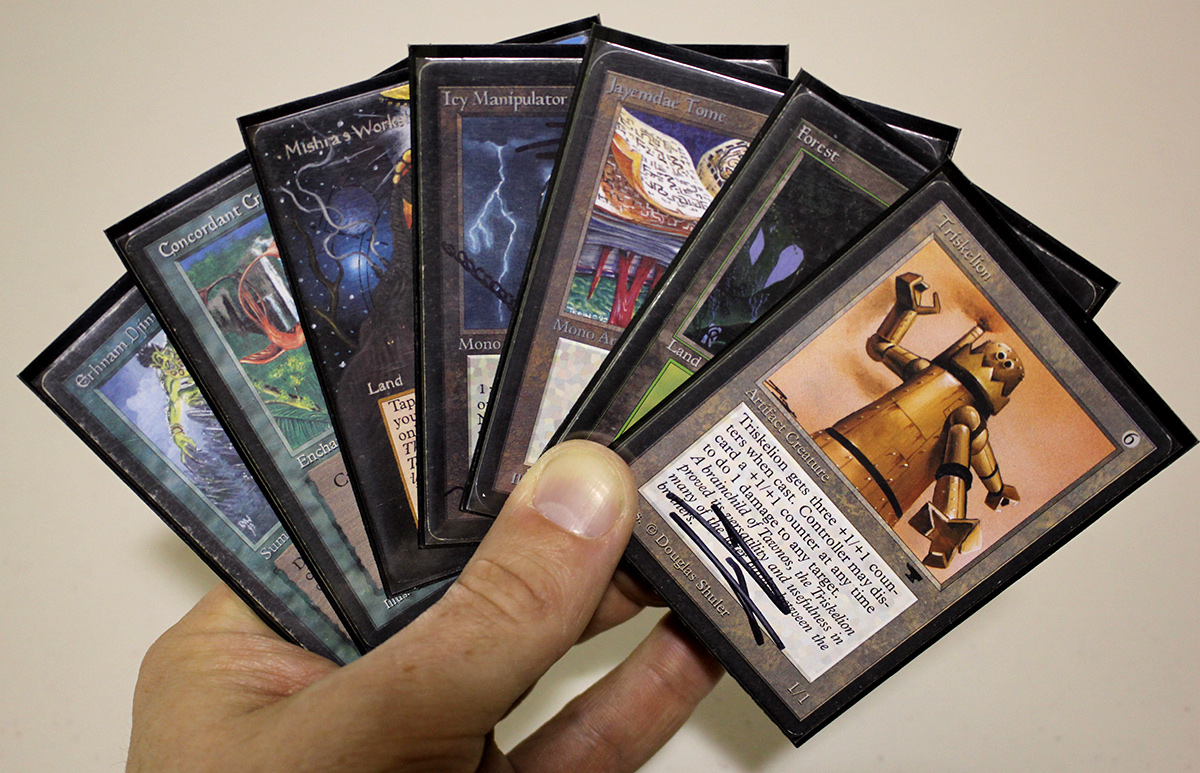
This is an average mix of spells and mana, but not great. I’d probably keep it and lead with Forest on the first turn, and then Icy Manipulator on the second turn (as the Jayemdae Tome won’t be useful for multiple turns). Icy can tie up your opponent’s mana on their upkeep for a few turns while you dig for more mana. If you know the opponent is on a creatureless strategy you can throw the Concordant Crossroads out on the first turn as well, but otherwise it’s better to just sandbag it for when you want it.
Opening Hand 10

The Moxen and Mana Vault will let you cast a first turn Icy, but this hand does nothing after that, with little prospect for victory if Icy is dealt with. I’m going to throw it back for another roll of the dice, and hopefully some better mana production.
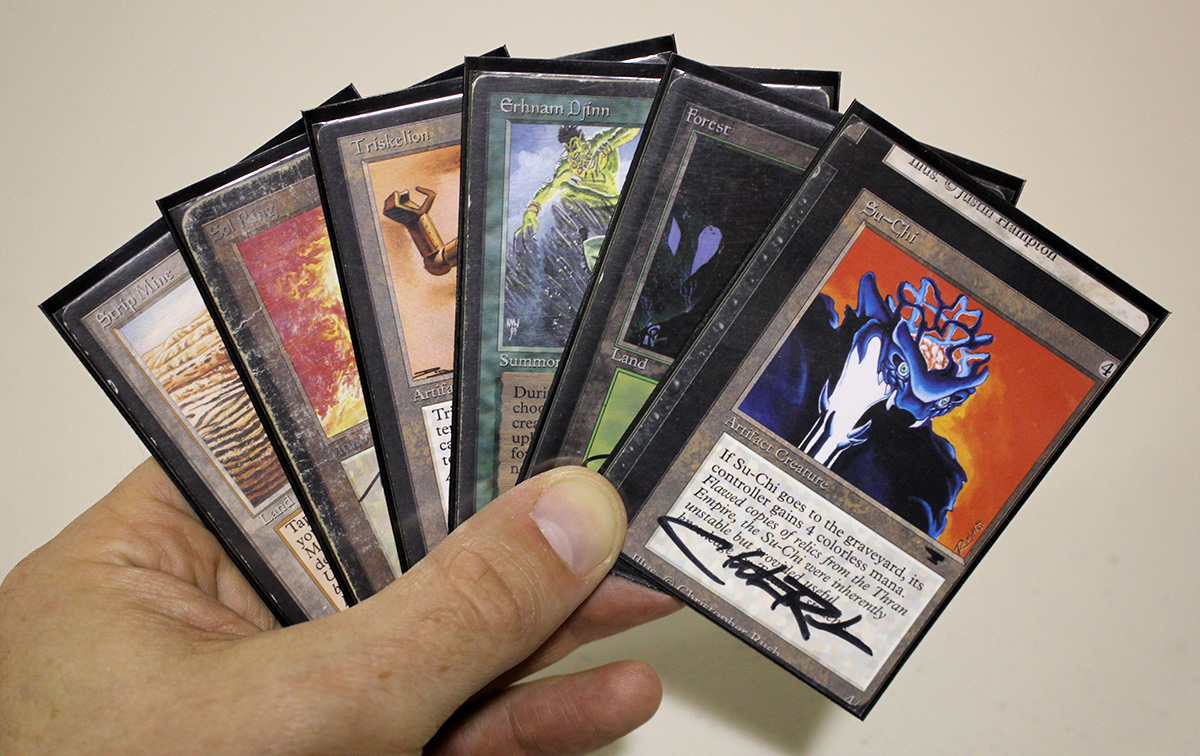
This is a reasonable hand of six, split evenly with mana and threats. I’d lead with Strip Mine in to Sol Ring on the first turn, and then cast Erhnam Djinn on the second turn probably, depending on what the opponent is doing.
Concluding Thoughts
This deck represents a fun direction to push Workshop Aggro. Concordant Crossroads can be used as a tool for dealing with opposing Enchant Worlds, as well as making all of your large creatures that much more quick and deadly against control decks. It’s a nice departure from standard Mono Green creature variants, and one with a lot of latitude for experimentation.
Stay tuned to Eternal Central for more sick 93-94 brews all month long. Thanks for reading.

